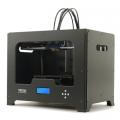Results 1 to 10 of 11
Thread: Dryer filament box
-
02-09-2016, 12:16 AM #1Student

- Join Date
- May 2015
- Posts
- 10
Dryer filament box
Hi
I started to make a filament dehydrator.
It can grow in my first test, the temperature of 75 ° C.
I hope soon to reach 85 ° C.
Control takes place with an electronic controller.
I heat all with resistance.
The air is mixed by a small fan which is resistant to 85 ° C.
I can put a 2kg spool.
It is put on bearings to rotate freely.
The drier is connected to the printer.
Thus, the filament is dehydrated during printing.
Everything is powered by 220V / 110V.
We can also add wall cylinder on the top to store more than 1 spool : max 3 spools of 2kg or 6 spools of 1kg.
What do you think ?
Assemblage 2.jpg
I think launching a kickstarter.
-
02-09-2016, 01:03 AM #2
The container looks sealed, where does the moisture go? What are the three slotted fins on the inside doing?
-
02-09-2016, 01:40 AM #3Student

- Join Date
- May 2015
- Posts
- 10
-
02-09-2016, 01:56 AM #4Engineer-in-Training

- Join Date
- Sep 2014
- Location
- Brummen, Netherlands
- Posts
- 265
Have you calculated the mass balances and equilibria for this? In any case you will need a means to regenerate the silica gel, or else have a truck load of it available.
You can find some good info here: http://www.apsnyc.com/uploads/Demyst...lica%20Gel.pdf
And also beware that RH (relative humidity) is a poor unit of measure as it is temperature dependent and relative. As you need to physically remove water and get rid of it (grams of water), it is better to calculate with the absolute humidity instead, as the water equilibria of polymer<->air and air<->silica both depend on the actual concentration of water in air (expressed in grams/m3).
Maybe a better approach would be to design a miniature air conditioner unit with a peltier element and collect and drain off the condensed water to outside the container.
-
02-09-2016, 02:44 AM #5Senior Engineer

- Join Date
- Jun 2014
- Location
- Burnley, UK
- Posts
- 1,662
Silica gel does not remove moisture when warm, it gives it out.
Cardboard boxs, duct tape, dryer exit hose and an de-humidifier unit is what you need.
-
02-09-2016, 05:01 AM #6
Hats off to the OP for attempting to make our world a little better. Hopefully with positive community feedback he can come up with something niche-filling...
-
02-09-2016, 05:37 AM #7Senior Engineer

- Join Date
- Jun 2014
- Location
- Burnley, UK
- Posts
- 1,662
I think that a Peltier pump in there to collect the water would work with a heater and something to take the water away. Like a small dehumidifier.
You could probably make something quite easily with a small wine fridge as your starting point.
-
02-09-2016, 05:44 AM #8
first off - for basic abs and pla 85c is way way too hot !
bear in mind that rolls of filament are very tightly packed. heating nthem to that temperature for any period of time will actually create a big lump of semi bonded plastic.
Also if the printer is drawing filament at 85 degress out of the dehydrator - that is very soft filament which will stretch, causing change in filament diameter and completely bollixing up your prints.
You need to be running it at around 40-50c with active air movement to remove the moisture.
It has to be a good way below the glass point of any filament or the minimum issues you get from 'wet' (I've never actualy had a problem) filament will be massively overshadowed by the problems caused by hot filament.
-
02-09-2016, 06:34 AM #9Student

- Join Date
- May 2015
- Posts
- 10
Yes I will try to dry with peltier plate
Also, actualy I can adjust the temp from 20 to 75. Effectively 75 - 85 deg is to muche for printing
Thanks for your help
-
03-02-2016, 07:36 PM #10Technician

- Join Date
- May 2014
- Posts
- 67
I would imagine a larger container with one side having warm, dry air (not above 60c as mentioned) pumped through, while on the other end a vacuum of sorts suck out the air. You could have underneath a bed of silica gel beads (maybe with a removable, air sealed tray), and of course the air pump IN would have to be stronger than the air vacuumed OUT, to give time for the filament to dry out.




 Reply With Quote
Reply With Quote








Extruder not feeding during print,...
04-24-2024, 01:59 AM in Tips, Tricks and Tech Help